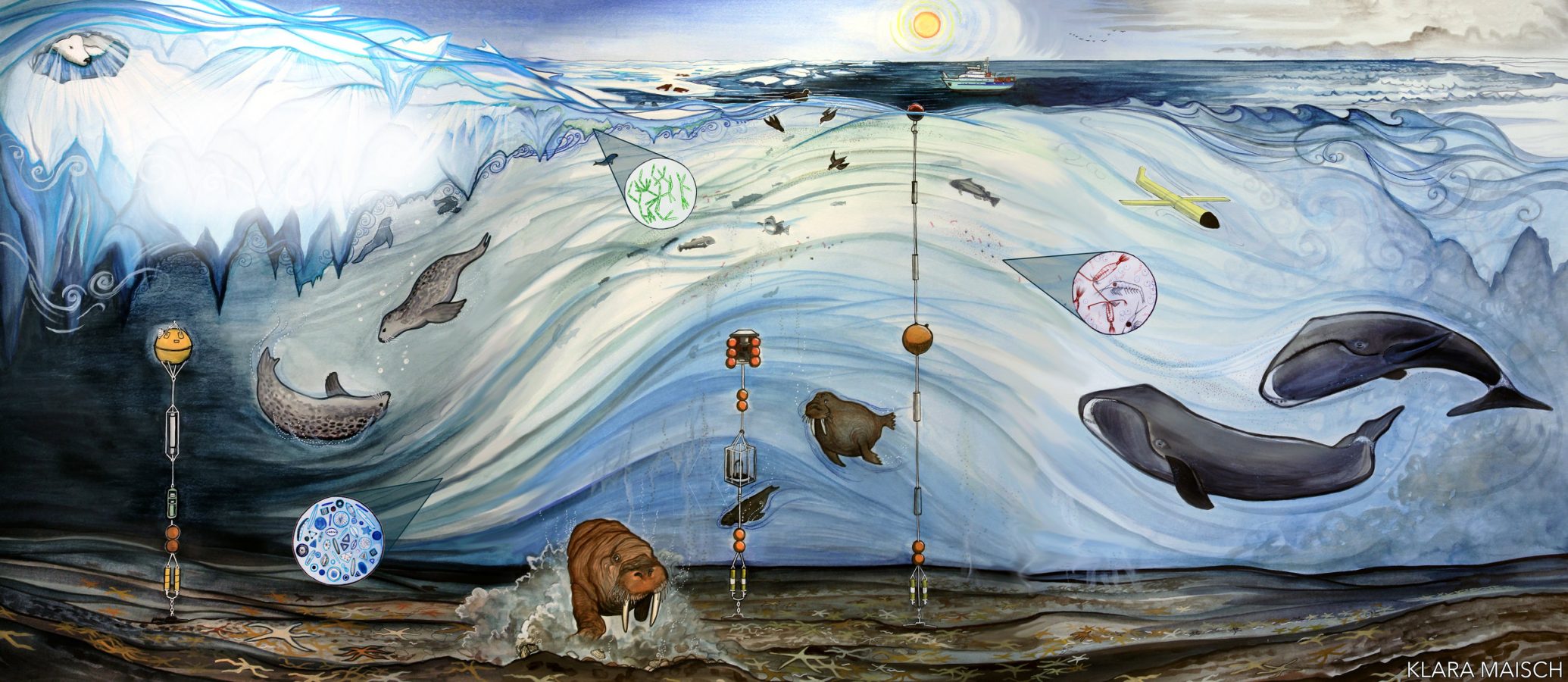Science and art illustrate changing marine Arctic ecosystem
December 4, 2018
Heather Rebekah McFarland
9074746286

A recent study led by ¿÷ª¢÷±≤• scientists Claudine Hauri and Seth Danielson is combining art and science to characterize the Chukchi Sea, a rapidly changing ecosystem off northwestern ¿÷ª¢÷±≤•.
The is the first Arctic monitoring site to continuously and simultaneously measure a large suite of biological, chemical and physical characteristics of the Chukchi Sea.
Over the last few decades, the region has seen dramatic shifts in sea ice cover, ocean temperature and storm activity. The observatory, three moorings densely outfitted with scientific sensors, is located more than 60 miles offshore at a biological hotspot where many walruses feed. Water, heat, nutrients and organisms from the Pacific Ocean pass through as they move northward into the Arctic Ocean.
The observatory, which is now in its fifth year of operation, expands the availability of year-round data on the region. That data is providing new information about how the Chukchi ecosystem operates, particularly during the ice-covered months.
“We anticipate that these data will be useful to policymakers and resource managers as they approach the questions of how to manage Arctic resources in the future,” said Danielson, a physical oceanographer at UAF’s College of Fisheries and Ocean Sciences and the observatory’s lead scientist.
Everything from the physics to the ice to the marine mammals are connected, explained Hauri, a chemical oceanographer at UAF’s International Arctic Research Center and lead author of a recently published paper in the journal Ocean Science. “It takes all of these sciences to understand the entire complex system.”
This complexity prompted Hauri and her team to enlist the help of Fairbanks artist Klara Maisch, who illustrated the seasonal variability of the Chukchi Sea in a three-piece painting. The painting will be on display at a First Friday art exhibit from 3 to 6:30 p.m. Dec. 7 in the lobby of the Akasofu Building on the Fairbanks campus’ West Ridge.
“It was a very interesting process to get to this painting,” said Hauri, “to explain something you’ve never seen but may have measured based on salinity, temperature and chlorophyll.”
For Maisch, the challenge was to represent a place that she hadn’t seen either.
“I tried to be accurate while realizing that it was still artwork,” she said. “There was a lot of back and forth.”
As a landscape artist, Maisch seldom draws walruses or scientific instruments, so the Chukchi seascape was her inspiration.
“I felt very comfortable getting to know the landscape through their research and the paper,” she said.
Hauri hopes the painting will help others connect with what is happening in the Chukchi. “Science is such an abstract thing,” she said. “Putting on the lens of an artist helps people understand what’s going on and what is important."
Other UAF scientists involved with the CEO project include Russ Hopcroft, Katrin Iken, Andrew McDonnell and Peter Winsor. Funding for the CEO is provided by a consortium that includes the ¿÷ª¢÷±≤• Ocean Observing System, the North Pacific Research Board and UAF.
Over the next five years, the team will continue to study how the Chukchi ecosystem functions, what is changing and why. The team plans to deploy similar observatories in other ¿÷ª¢÷±≤• waters, starting with the Gulf of ¿÷ª¢÷±≤•.
ADDITIONAL CONTACTS: Claudine Hauri, 907-474-7059, chauri@alaska.edu; Seth Danielson, 907-474-7834, sldanielson@alaska.edu; Klara Maisch, klaramaisch@gmail.com.
NOTE TO EDITORS: Visit the journal Ocean Science at to download the paper. The Chukchi seascape is available to download at .


